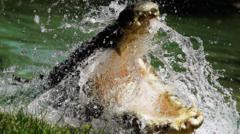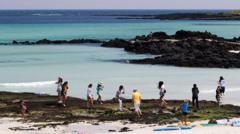There’s a delicate balance being struck in Australia’s Northern Territory as it becomes both a crocodile haven and a hotspot for human activity. This juxtaposition is at the forefront of the concerns facing Darwin, a coastal city surrounded by water and estimated to be home to over 100,000 saltwater crocodiles, the world's largest living reptiles. Government ranger Kelly Ewin, tasked with capturing and removing these reptiles, faces daily challenges in this dynamic environment.
"Our job is to ensure the safety of the public and manage the crocodiles effectively," Ewin remarks, as the tranquil dawn of Darwin Harbour contrasts with the lurking dangers beneath the surface. Once nearly hunted to extinction, saltwater crocodiles have rebounded since hunting was banned in 1971, and the species is now classified as protected but abundant.
Across the region, safety measures are imperative as crocodiles become increasingly visible, especially during breeding seasons when they rove more widely. Although fatal encounters remain rare, they happen—recently, a tragic incident involving a young girl reignited public fears about the reptiles’ proximity to human activity, prompting further discussion regarding their population management.
For years, the Northern Territory has adopted a management plan that balances human safety and crocodile conservation. The latest initiative includes increasing the annual quota of crocodiles that can be killed from 300 to 1,200. In this context, community education plays a critical role, with programs like "Be Crocwise" helping residents learn how to coexist safely.
Despite the potential risk, crocodiles are pivotal to the region’s economy, luring tourists seeking to see these apex predators in their natural habitat. Tour operators have capitalized on this interest, offering adrenaline-inducing "croc jumping" experiences while also drawing attention to the importance of respecting these formidable beasts.
Crocodile farming has emerged as a significant industry following the ban on hunting. This practice allows for the harvesting of crocodile skins, which are sought after by luxury fashion brands, creating economic opportunities and encouraging community engagement in sustainable practices. Proponents of farming argue that it facilitates a unique balance between conservation and economic development, especially for Aboriginal communities that have historically interacted with these reptiles.
Yet, dissenting voices express concern regarding animal welfare, particularly about how the reptiles are managed and confined for farming. Critics highlight the need for responsible practices that align with ethical standards while promoting coexistence.
In summary, the discourse surrounding saltwater crocodiles in Darwin reveals a complex intersection of conservation, safety, childhood memories, and community educational initiatives. As local authorities work to manage this predator effectively while nurturing industry and tradition, the future of human-crocodile interactions in the Northern Territory remains a pivotal question—one that will demand ongoing attention and solutions as the dynamic continues to evolve.
"Our job is to ensure the safety of the public and manage the crocodiles effectively," Ewin remarks, as the tranquil dawn of Darwin Harbour contrasts with the lurking dangers beneath the surface. Once nearly hunted to extinction, saltwater crocodiles have rebounded since hunting was banned in 1971, and the species is now classified as protected but abundant.
Across the region, safety measures are imperative as crocodiles become increasingly visible, especially during breeding seasons when they rove more widely. Although fatal encounters remain rare, they happen—recently, a tragic incident involving a young girl reignited public fears about the reptiles’ proximity to human activity, prompting further discussion regarding their population management.
For years, the Northern Territory has adopted a management plan that balances human safety and crocodile conservation. The latest initiative includes increasing the annual quota of crocodiles that can be killed from 300 to 1,200. In this context, community education plays a critical role, with programs like "Be Crocwise" helping residents learn how to coexist safely.
Despite the potential risk, crocodiles are pivotal to the region’s economy, luring tourists seeking to see these apex predators in their natural habitat. Tour operators have capitalized on this interest, offering adrenaline-inducing "croc jumping" experiences while also drawing attention to the importance of respecting these formidable beasts.
Crocodile farming has emerged as a significant industry following the ban on hunting. This practice allows for the harvesting of crocodile skins, which are sought after by luxury fashion brands, creating economic opportunities and encouraging community engagement in sustainable practices. Proponents of farming argue that it facilitates a unique balance between conservation and economic development, especially for Aboriginal communities that have historically interacted with these reptiles.
Yet, dissenting voices express concern regarding animal welfare, particularly about how the reptiles are managed and confined for farming. Critics highlight the need for responsible practices that align with ethical standards while promoting coexistence.
In summary, the discourse surrounding saltwater crocodiles in Darwin reveals a complex intersection of conservation, safety, childhood memories, and community educational initiatives. As local authorities work to manage this predator effectively while nurturing industry and tradition, the future of human-crocodile interactions in the Northern Territory remains a pivotal question—one that will demand ongoing attention and solutions as the dynamic continues to evolve.



















